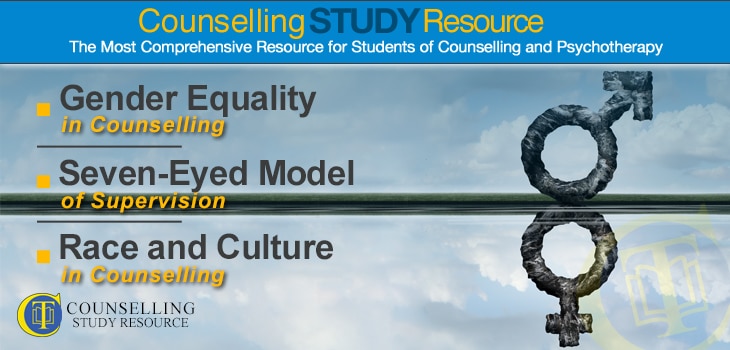055 – Gender Equality in Counselling – Seven-Eyed Model of Supervision – Race and Culture in Counselling
In episode 55 of the Counselling Tutor Podcast, Ken and Rory discuss gender equality in counselling. ‘Theory with Rory’ examines Robin Shohet and Peter Hawkins’ seven-eyed model of supervision. The podcast ends with a debate on race and culture in counselling.
Gender Equality in Counselling (starts at 2.27 mins)
How would you deal with a client whose cultural expectations gave her less autonomy than in your own culture? Rory notes that while we can’t change the world, we can model who we are ourselves, and that clients may choose to change who they are.
However, we are all heavily influenced by our heritage, the influences of which can be external to ourselves. It is all too easy to inadvertently bring our own biases into the counselling room: personal development (to build self-awareness, including through personal counselling) and supervision are key here to safeguarding against this.
Whatever their culture, some people realise during counselling training that they have less autonomy than they once thought, and are determined to address this. There is a history in counselling of there being more female practitioners but of many of the ‘big names’ being male, particularly historically. For example, it is thought that Laura Posner Perls (who was married to Fritz Perls, widely thought of as the founder of gestalt therapy) in fact thought up this modality.
Similarly, Jesse Taft was a huge influence on Carl Rogers’ work – she founded the basic approach of social work, and also informed Rogers’ work at Rochester.
Seven-Eyed Model of Supervision (starts at 12.16)
Understanding models of supervision can help us get the best out of our supervision, informing what we take to our supervisor. Having a common language can support us to work more cooperatively and collegially together.
One model that is used widely is that by Shohet and Hawkins, as described in their book Supervision in the Helping Professions (Open University Press, 2012). This model is popular not only in counselling and psychotherapy but also in coaching, social work and support work.
The ‘seven eyes’ refers to seven different ways of looking at the client presentation and related relationships. These focus on the:
- client
- supervisee’s interventions
- client–supervisee relationship
- supervisee’s own experiences
- supervisor–supervisee relationship
- supervisor’s own reflections
- wider context
Rory gives examples from real life of what might be discussed under each ‘eye’. Rory’s handout on this topic is free to download via the button above.
Race and Culture (starts at 27.49 mins)
Rory asks: ‘What is race?’ He explains that the term comes from an old French word meaning ‘family’. Race is an artificial construct developed in 1tth- and 18th-century Europe. The German physician and anthropologist Johann Friedrich Blumenbach developed it as a taxonomy, in order to categorise people.
Rory and Ken feel that race is not a meaningful concept, instead preferring culture, which embraces a wide range of aspects of how a person lives. Ken refers to Johnny Clegg, a South African pop star who originally trained as an anthropologist. His song ‘The Scatterlings of Africa’ highlights that we all come originally from African stock.
Rory advises that if the subject of a person’s heritage does arise – whether in the counselling room or in daily life – don’t shy away from talking about it. Some people can be worried about causing offence, but if you come from a place of honesty, enquiry and respect, the likelihood is that most people will respond.
You can download Ken’s handout on the iceberg concept of culture here.


